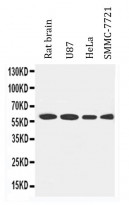ARG42192
anti-LCAT / Lecithin Cholesterol Acyltransferase antibody
anti-LCAT / Lecithin Cholesterol Acyltransferase antibody for Western blot and Human,Rat
Overview
| Product Description | Rabbit Polyclonal antibody recognizes LCAT / Lecithin Cholesterol Acyltransferase |
|---|---|
| Tested Reactivity | Hu, Rat |
| Tested Application | WB |
| Host | Rabbit |
| Clonality | Polyclonal |
| Isotype | IgG |
| Target Name | LCAT / Lecithin Cholesterol Acyltransferase |
| Antigen Species | Human |
| Immunogen | Synthetic peptide corresponding to aa. 300-313 of Human LCAT / Lecithin Cholesterol Acyltransferase. (RDFQRFFADLHFEE) |
| Conjugation | Un-conjugated |
| Alternate Names | Phosphatidylcholine-sterol acyltransferase; Phospholipid-cholesterol acyltransferase; Lecithin-cholesterol acyltransferase; EC 2.3.1.43 |
Application Instructions
| Application Suggestion |
|
||||
|---|---|---|---|---|---|
| Application Note | * The dilutions indicate recommended starting dilutions and the optimal dilutions or concentrations should be determined by the scientist. | ||||
| Positive Control | Rat brain, U87, HeLa and SMMC-7721 | ||||
| Observed Size | ~ 60 kDa |
Properties
| Form | Liquid |
|---|---|
| Purification | Affinity purification with immunogen. |
| Buffer | 0.2% Na2HPO4, 0.9% NaCl, 0.05% Thimerosal, 0.05% Sodium azide and 5% BSA. |
| Preservative | 0.05% Thimerosal and 0.05% Sodium azide |
| Stabilizer | 5% BSA |
| Concentration | 0.5 mg/ml |
| Storage Instruction | For continuous use, store undiluted antibody at 2-8°C for up to a week. For long-term storage, aliquot and store at -20°C or below. Storage in frost free freezers is not recommended. Avoid repeated freeze/thaw cycles. Suggest spin the vial prior to opening. The antibody solution should be gently mixed before use. |
| Note | For laboratory research only, not for drug, diagnostic or other use. |
Bioinformation
| Database Links |
Swiss-port # P04180 Human Phosphatidylcholine-sterol acyltransferase |
|---|---|
| Gene Symbol | LCAT |
| Gene Full Name | lecithin-cholesterol acyltransferase |
| Background | This gene encodes the extracellular cholesterol esterifying enzyme, lecithin-cholesterol acyltransferase. The esterification of cholesterol is required for cholesterol transport. Mutations in this gene have been found to cause fish-eye disease as well as LCAT deficiency. [provided by RefSeq, Jul 2008] |
| Function | Central enzyme in the extracellular metabolism of plasma lipoproteins. Synthesized mainly in the liver and secreted into plasma where it converts cholesterol and phosphatidylcholines (lecithins) to cholesteryl esters and lysophosphatidylcholines on the surface of high and low density lipoproteins (HDLs and LDLs) (PubMed:10329423, PubMed:19065001, PubMed:26195816). The cholesterol ester is then transported back to the liver. Has a preference for plasma 16:0-18:2 or 18:O-18:2 phosphatidylcholines (PubMed:8820107). Also produced in the brain by primary astrocytes, and esterifies free cholesterol on nascent APOE-containing lipoproteins secreted from glia and influences cerebral spinal fluid (CSF) APOE- and APOA1 levels. Together with APOE and the cholesterol transporter ABCA1, plays a key role in the maturation of glial-derived, nascent lipoproteins. Required for remodeling high-density lipoprotein particles into their spherical forms (PubMed:10722751). [UniProt] |
| Cellular Localization | Secreted. Note=Secreted into blood plasma (PubMed:3458198, PubMed:8820107, PubMed:10222237). Produced in astrocytes and secreted into cerebral spinal fluid (CSF). [UniProt] |
| Calculated MW | 50 kDa |
| PTM | O- and N-glycosylated. O-glycosylation on Thr-431 and Ser-433 consists of sialylated galactose beta 1-->3N-acetylgalactosamine structures. N-glycosylated sites contain sialylated triantennary and/or biantennary complex structures. [UniProt] |
Images (1) Click the Picture to Zoom In






